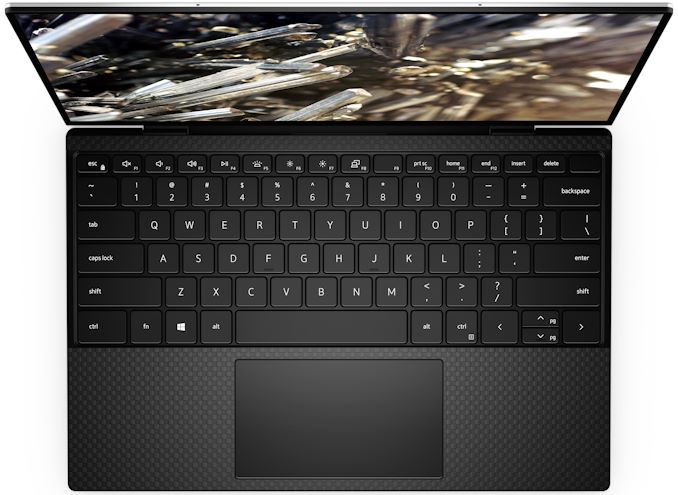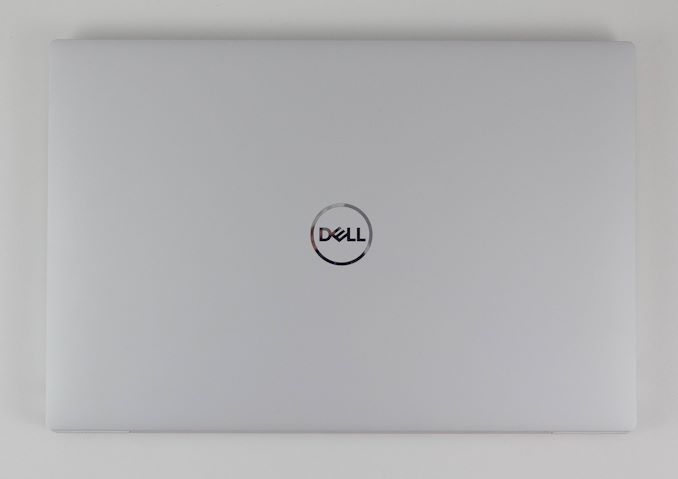The Dell XPS 13 (9300) Review: Return of the King
by Brett Howse on July 16, 2020 10:00 AM ESTDesign
Dell pioneered the thin-bezel laptop, but that does not mean they did not have room to improve on their original design over the years. The first several generations featured a webcam at the bottom of the panel, which was flattering to no one. With the proliferation of video chat, such a decision would be a major negative to many people. But thankfully Dell solved that particular issue a couple of generations ago, and the new model continues to pack a 720p webcam in the correct location above the display, with only a slightly taller top display bezel to accommodate the camera. And speaking of the display bezel, Dell has tweaked their design language slightly over the XPS 13 2-in-1, with both the black and white models both featuring a black display bezel on the clamshell XPS 13, which helps it disappear into the background a bit easier than the white bezel on the 2-in-1.

The XPS 13 in Platinum Silver with black carbon fiber
Another nice change over the 2-in-1 version is that Dell is not using their MagLev keyboard design, instead outfitting the XPS 13 with a more traditional scissor-switch keyboard with 1.0 mm of travel. The MagLev has a very short throw, whereas I find the traditional keyboard to be much more reassuring to use.
Dell is offering the XPS 13 in the same color choices as the 2-in-1 as well. The Platinum Silver model features a black carbon fiber keyboard deck with a soft-touch coating, while the Arctic White model features a woven fiber keyboard deck which Dell has treated with a stain and UV resistant coating, to prevent the deck from yellowing with age. The Arctic White is only $49 more, and certainly makes a statement, although it still suffers from the same issue as all white-on-white laptops with white backlighting, which is that the keyboard backlighting can wash out the keys in a bright room. That is a fairly minor negative though, for an otherwise fantastic finish.
The XPS 13 also features an excellent trackpad, offering a very smooth finish, and good precision. Laptop trackpads have come a long way, and part of that is the standardization on the Microsoft Precision touchpad drivers, which Dell employs here.
Dell has eschewed the use of USB Type-A ports, instead offering just a single USB Type-C port on each side of the laptop. This in turn is paired with a 3.5 mm headset jack on the right, and a micro SD card reader on the left. Although the XPS 13 lacks ports in numbers, it somewhat makes up for that with both USB ports supporting Thunderbolt 3, including power delivery. It is unfortunate that the Type-C port has found itself to be so confusing in its capabilities, but with the XPS 13 supporting the full range of protocols, as well as four lanes of PCIe on both ports, that at least is not a liability here. Dell does include a Type-C to Type-A adapter in the box as well, for those that require the larger port. By including power delivery on both sides of the laptop, that also means the XPS 13 can charge on either side, which can be very handy when moving the laptop from place to place.
Dell’s design ethos with their XPS lineup has converged across the entire range of XPS laptops, and with great success. The CNC milled aluminum bodies, thin bezels, compact designs, and lightweight chassis make for some of the most compelling devices in the industry. Moving to a 16:10 aspect ration on their XPS line has been yet another design win for Dell, and helps provide the excellent 91.5% screen to body ratio found on this XPS 13 notebook by further shrinking the bottom bezel. Dell has sculpted a clean, sleek, and functional device, and while the rest of the industry has also adopted the thin-bezel design, Dell has really mastered it.













224 Comments
View All Comments
Korguz - Friday, July 17, 2020 - link
Santoval, look who made the comment, there is no need to say anything else. its self explainitory.Santoval - Friday, July 17, 2020 - link
Is it? I have no idea who "Deicidium" is, sorry..Korguz - Friday, July 17, 2020 - link
then you haven't been reading here that much. he will bash and any chance he can, while praising his gods intel and nvidia, with no proof at all of his claims.Korguz - Friday, July 17, 2020 - link
bash amd any chance he canDeicidium369 - Friday, July 17, 2020 - link
I got you mixed up with Spungy, have no clue who you are either.Deicidium369 - Friday, July 17, 2020 - link
Run along little boy.Deicidium369 - Friday, July 17, 2020 - link
Zen 1 vs Zen 3 are minor architectural tweaks and improved manufacturing and packaging ("chiplets" and IO die) - per core performance has not increased any more than Skylake to to Coffee Lake to Comet Lake. Minor tweaks. So still competing at Skylake level perormance.Well moved on - Last 14nm server CPU has shipped - last 14nm desktop CPU is shipping later this year. Ice Lake is widespread enough to count - in way more designs than AMD.
Leaks show that 8C monstrosity to be 17% better perf than 4 cores on Tiger Lake.
Rocket Lake is basically backported Ice Lake/Tiger Lake to 14nm - so no Skylake there. Sunny Cove/Willow Cove/Golden Cove ARE NOT SKYLAKE. New arch. I know you know this.
Korguz - Friday, July 17, 2020 - link
going by that same logic, all intel cpu's since skylake are also minor architectural tweaks and improved manufacturing as well, whats your point ?" Last 14nm server CPU has shipped - last 14nm desktop CPU is shipping later this year" oh ? lets see you post proof of this. oh wait, you cant, cause there isnt any proof.
" Leaks show that 8C monstrosity to be 17% better perf than 4 cores on Tiger Lake. " like another mentioned, still cherry picking are you ?
IF it was a new architecture, intel them selves would of called it gen 1, not gen 10/11/12/etc.
schujj07 - Saturday, July 18, 2020 - link
Per core performance hasn't increased from Zen 1 to Zen+, to Zen 2??? Whatever you are smoking I hope you share. Clock for clock Zen 2 is about 18% faster than Zen 1, that means per core performance is higher. Whereas Intel hasn't increased per core performance since 2015. Before that Intel hadn't had more than minor changes since the change from Nehlema to Sandy Bridge. After that they had nothing more that 5% IPC improvements, all other performance increase was sheer clock speed.Odds are that Rocket Lake will not clock as high as Skylake derivatives. It will need to have a massively higher IPC to counteract the loss of clock compared to Comet Lake. On top of that it will probably be very power hungry due to the bigger chip and added complexity.
gescom - Friday, July 17, 2020 - link
Similar single performance at much lower power consumption.https://www.notebookcheck.net/Lenovo-ThinkPad-T14s...